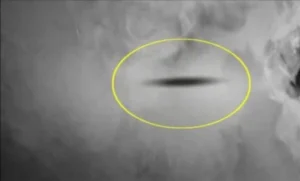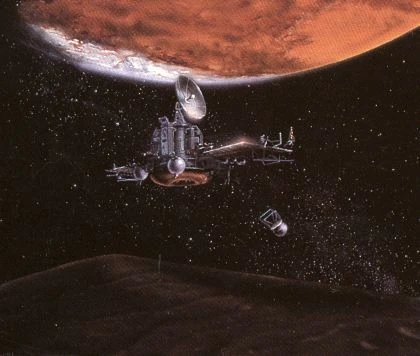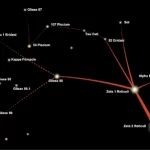Phobos (Greek Φόβος ‘fear’) – the larger of the two moons of Mars. A natural satellite orbiting the closest to its planet in the Solar System. In Greek mythology, Phobos was the son of Ares (Mars) and Aphrodite (Venus).
Phobos Program (Russian: Фобос) – a flight program of two Soviet unmanned space probes sent in 1988. The aim of their mission was to conduct detailed studies of the Martian moon Phobos. The probes were to make very close passes over the surface of Phobos, place landers on it, make observations of the surface and atmosphere of Mars, and also conduct observations of the Sun and interplanetary space.
Phobos-1 was the first Soviet probe designed to study the larger moon of Mars, launched from Earth on July 7, 1988, equipped with a lander to be placed on Phobos – a mission that ended in failure. Officially, due to sending an incorrect command that turned off the stabilization and orientation system (instead of turning on the gamma-ray spectrometer), which caused the loss of communication with the probe. It was never restored.
Phobos-2 was the second Soviet probe designed to study the larger moon of Mars, launched from Earth on July 12, 1988, equipped with two landers to be placed on Phobos. Officially, communication with the probe was lost. The probable cause was a failure of the on-board computer, which controlled the probe’s orientation and showed some irregularities during the interplanetary flight. Other causes include the probe’s collision with a micrometeor or electrical interference near Phobos.
Before contact with Phobos-2 was lost, the probe managed to send photos from Mars taken with two cameras, a regular one and an infrared one. The transmitted photos showed a shadow of a cigar-shaped object flying between Mars and the Phobos-2 probe. This may suggest the presence of an unidentified flying object in the airspace or orbit of Mars, shaped like a cigar or a disk.

The probe was redirected from Mars’ orbit to the vicinity of its moon Phobos, where the probe was probably shot down by laser beams. The proof is the last photo sent from Phobos-2 to Earth showing a spot (ball) of light approaching the probe. After this event, contact with Phobos-2 was lost.

Considering that the still hypothetical Planet X, called Nibiru or the Planet of Transition in ancient Sumer, completes its trajectory around the Sun in 3600 years, passing between Mars and Jupiter.
Extraterrestrial visitors from Nibiru (Sumerian: Anunnaki) could have built a transfer station in the ancient past, e.g. on Mars’ moon Phobos.
Following this line of thought, it is possible that the station on Phobos still operates in secret, regardless of whether it is operated by a staff of living extraterrestrial beings or robots, androids or other devices left behind by them.
In both cases, the station on Phobos will defend its secret by destroying any object that comes within dangerous distance.
Assuming that the Anunnaki established a colony on Earth 450,000 years ago, laying the foundations for Homo Sapiens, they could also have built a transshipment station near Earth, e.g. on the moon Phobos, which is still in operation today.
This gives rise to further speculations, thanks to which we can assume that intelligent extraterrestrial beings are still among us or in close interplanetary distance.
Whether my argument makes sense or not – everyone, as always, must answer this question for themselves.






its possible, but difficult to make sure what happened there